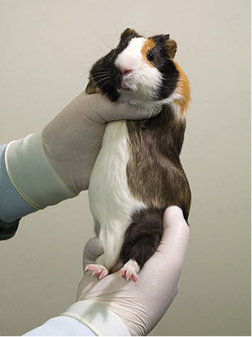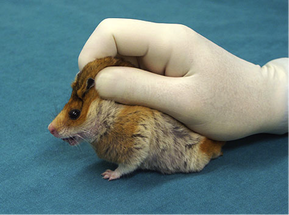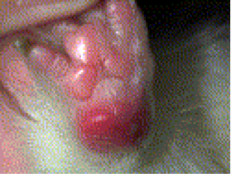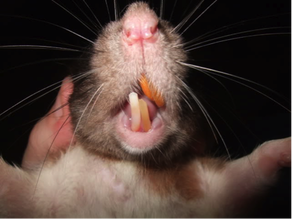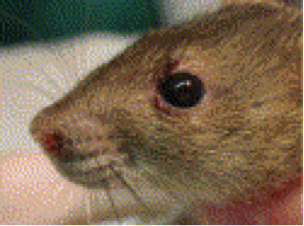Husbandry, Handling, and Common Diseases of Guinea Pigs, Rats, and Hamsters
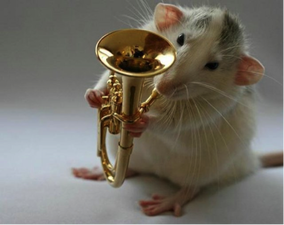
From http://forum.xcitefun.net/cute-rat-musician-t36504.html
By Allison Clarke, second-year veterinary student and Dane County Humane Society Animal Medical Services summer intern
As pocket pets become increasingly popular, shelters and humane societies will see more admissions of these friendly little guys. The following article covers some basic protocols for housing and handling of some popular pocket pets – guinea pigs, rats, and hamsters – as well as a review of common health problems.
Housing
Rodents can be housed in either solid-sided cages (ie. aquariums) or wire cages. In general, wire cages are easier to clean and are less prone to build up toxic ammonia fumes when they get dirty. However, in a shelter environment, cleaning concerns need to be balanced with the risk of respiratory disease transmission. If wire cages are used, be sure that cages are spaced far enough apart that animals cannot sneeze or cough on each other between cages. Pregnant females, or females that may be pregnant, should be housed in solid-sided cages so that newborns do not slip out between the wires.
In any kind of cage, solid floors are preferable to wire floors. Rodent feet are small and can get trapped in wire mesh floors, leading to bone fractures or other injuries. Wire floors also increase the risk of bumblefoot, a common foot infection which will be discussed below.
Bedding can be the most expensive component of rodent care, and there is controversy over whether certain kinds of beddings increase the risk of respiratory disease. However, we do know that cedar shavings release chemicals that can affect liver function, so they should be avoided. Both DCHS and the author have had good results using old sheets as bedding; they can be changed daily, don’t release any dust or odor, and are cheap to wash. Towels should be avoided as the little loops that make up terrycloth can become snagged on toes and cause injury. The sheets also allow easy monitoring of urine and feces for possible abnormalities. To keep cages clean, toilet areas should be changed daily and the whole cage cleaned at least once a week (more often for solid-sided cages to avoid ammonia buildup).
As pocket pets become increasingly popular, shelters and humane societies will see more admissions of these friendly little guys. The following article covers some basic protocols for housing and handling of some popular pocket pets – guinea pigs, rats, and hamsters – as well as a review of common health problems.
Housing
Rodents can be housed in either solid-sided cages (ie. aquariums) or wire cages. In general, wire cages are easier to clean and are less prone to build up toxic ammonia fumes when they get dirty. However, in a shelter environment, cleaning concerns need to be balanced with the risk of respiratory disease transmission. If wire cages are used, be sure that cages are spaced far enough apart that animals cannot sneeze or cough on each other between cages. Pregnant females, or females that may be pregnant, should be housed in solid-sided cages so that newborns do not slip out between the wires.
In any kind of cage, solid floors are preferable to wire floors. Rodent feet are small and can get trapped in wire mesh floors, leading to bone fractures or other injuries. Wire floors also increase the risk of bumblefoot, a common foot infection which will be discussed below.
Bedding can be the most expensive component of rodent care, and there is controversy over whether certain kinds of beddings increase the risk of respiratory disease. However, we do know that cedar shavings release chemicals that can affect liver function, so they should be avoided. Both DCHS and the author have had good results using old sheets as bedding; they can be changed daily, don’t release any dust or odor, and are cheap to wash. Towels should be avoided as the little loops that make up terrycloth can become snagged on toes and cause injury. The sheets also allow easy monitoring of urine and feces for possible abnormalities. To keep cages clean, toilet areas should be changed daily and the whole cage cleaned at least once a week (more often for solid-sided cages to avoid ammonia buildup).
|
|
Diet
Guinea Pigs: A normal guinea pig diet should consist of guinea pig-specific pellets, fresh veggies, and free-choice grass hay. Guinea pigs may be picky eaters, so new foods should be introduced gradually.Unlike most other animals, guinea pigs do not produce their own Vitamin C and require it in their diets. Guinea pig feeds may have added Vitamin C, but it breaks down shortly after manufacturing. Therefore, pellets should be supplemented with fresh vegetables or drops added to the water. If you choose to use drops, the appropriate dose is 1 g Vitamin C/liter; however, like the feed additives, this compound is volatile and needs to be remixed and replaced every day. Also, keep in mind that some pigs don’t like the taste of drops and may stop drinking their water when drops are added. Rats and hamsters: Pelleted diets (“blocks”) are always preferable to seed diets. Seed diets are fattening and may be deficient in certain vitamins and minerals, especially since the animals can pick through the food and only eat their favorite components. Handling Guinea pigs: Guinea pigs are easy to handle and can usually be examined on a table with just an assistant's hand behind the rump. If more restraint is needed, place the other hand around the animal’s shoulders/chest. The pig can then be held upright so that your rump hand is supporting it, with the thumb of the chest hand placed under the jaw to restrain the head. Rats: Rats are easy to handle, especially if you take the time to make friends first. Handle them similarly to guinea pigs, with one hand over the shoulders and the other behind the rump, if full restraint is needed. NEVER handle or restrain a rat by the tail, as this can lead to the skin slipping off (“degloving”) – a serious injury that requires amputation. Hamsters: Hamsters are more difficult to handle and can become stressed during the process. Many hamsters are prone to escape artistry when being handled, so restraining close to a surface (the table or floor) is preferred. For full restraint, use the loose skin along the hamster's back to scruff it as you would a cat, except use your whole hand to extend the scruff along the length of the body. |
|
Medical Concerns
Common to all species: Pododermatitis, or bumblefoot, is a painful infection and inflammation of the hind foot. It can present as a raised red patch or open sore on the foot, which may bleed or leak pus. It is caused by prolonged exposure to urine and feces, especially in combination with the use of wire flooring. Once bumblefoot starts, it can be difficult to treat, so prevention is best. Keep cages clean and do not use cages with wire floors. Any rodent species can contract mites, which can cause itching and fur loss. Ivermectin is generally effective for mite infestations in rodents, but be sure to confirm with a vet that mites are causing the symptoms before treating. Malocclusion is the poor apposition of the teeth, especially the incisors. Guinea pigs, rats, and hamsters all have incisors that are constantly growing and need to be worn down. If their bite doesn’t line up correctly, one or more of the teeth will overgrow, which can make eating difficult. If a rodent’ s teeth don’t look even, or if you notice excess salivation, difficulty eating, or loss of appetite that can’t be attributed to another cause, consider having a vet check for malocclusion. The teeth can be trimmed to bring them back into alignment. However, remember that malocclusion is a chronic condition that will require regular veterinary care for the rest of the animal’s life, which may affect their adoptability. |
|
Guinea pigs: Guinea pigs are prone to antibiotic-associated enterotoxemia, a severe bout of diarrhea that occurs after treatment with antibiotics. Diarrhea then causes dehydration, hypothermia, and loss of appetite. In order to prevent this condition, always consult a veterinarian before giving antibiotics to a guinea pig. The vet can help you find an antibiotic that will maintain healthy gut flora in your pig.
Guinea pigs can get pneumonia from Bordetella, the same bacterium that infects dogs and rabbits. Never house guinea pigs and rabbits together, and always care for guinea pigs before coming into contact with dogs that might have kennel cough. Guinea pigs can also get ringworm, so practice good hygiene to prevent transmission from ringworm-suspect cats.
Lastly, guinea pigs are prone to bladder stones, which can cause loss of appetite, blood in the urine or failure to urinate, and hunched or painful posture. These stones are generally made of calcium, so it may be wise to avoid high-calcium foods in your guinea pigs’ diets. Kale, broccoli, and turnips are high in calcium, as are some hays (ie. alfalfa). Timothy hay is a good, less-calcium alternative. Increasing pigs’ water intake, for example by misting their vegetables with water before feeding, may also help them flush out urinary debris.
Guinea pigs can get pneumonia from Bordetella, the same bacterium that infects dogs and rabbits. Never house guinea pigs and rabbits together, and always care for guinea pigs before coming into contact with dogs that might have kennel cough. Guinea pigs can also get ringworm, so practice good hygiene to prevent transmission from ringworm-suspect cats.
Lastly, guinea pigs are prone to bladder stones, which can cause loss of appetite, blood in the urine or failure to urinate, and hunched or painful posture. These stones are generally made of calcium, so it may be wise to avoid high-calcium foods in your guinea pigs’ diets. Kale, broccoli, and turnips are high in calcium, as are some hays (ie. alfalfa). Timothy hay is a good, less-calcium alternative. Increasing pigs’ water intake, for example by misting their vegetables with water before feeding, may also help them flush out urinary debris.
|
Rats: Rats are prone to upper respiratory infections, which cause the discharge of red mucus from the eyes and nose. This substance is not blood, even though it may look scary – rats’ nasal discharge contains porphyrin, which is red. Upper respiratory symptoms may be brought on by stress, poor housing, or dust from bedding in combination with a pre-existing bacterial infection. Breakouts can usually be controlled with antibiotics, although infections may become chronic.
Rats – especially unspayed females – also frequently develop mammary tumors. Their mammary tissue is spread over most of their body, so these tumors may show up anywhere from the shoulders to the hindlimbs. Mammary tumors in rats are usually benign, but can eventually get quite large and interfere with moving or eating. Surgical removal by a vet is the best option. However, once one tumor has formed, more are likely to appear. |
Hamsters: Like guinea pigs, hamsters are prone to diarrhea following antibiotic treatment. They can also develop diarrhea due to infection with the bacteria Lawsonia intracellularis. This infection is called “wet-tail” and usually breaks with stress (ie. on moving from a home to a shelter). It tends to affect younger animals. Diarrhea can be extremely serious in small animals such as hamsters, because they dehydrate quickly. Consult a veterinarian immediately if you suspect severe diarrhea. Wet-tail can be fatal if prompt medical attention is not given.
Vaginal discharge may alarm volunteers, but is a perfectly normal finding at the end of a hamster’s estrous cycle. The discharge should be white – bloody discharge may indicate infection.
Good Reads: the following resources may help answer your questions about small rodents.
Vaginal discharge may alarm volunteers, but is a perfectly normal finding at the end of a hamster’s estrous cycle. The discharge should be white – bloody discharge may indicate infection.
Good Reads: the following resources may help answer your questions about small rodents.
- AHWLA UK http://www.ahwla.org.uk/site/tutorials/BVA/BVA02-Introduction.html provides a good overview of handling techniques for various rodents. Geared toward laboratory animals, but information is widely applicable.
- Rat Guide http://ratguide.com/ has an in-depth health section with discussions and case studies of many common rat conditions.
- RSPCA Australia http://kb.rspca.org.au/33/ has an interactive knowledge base that includes sections on rats and guinea pigs.
